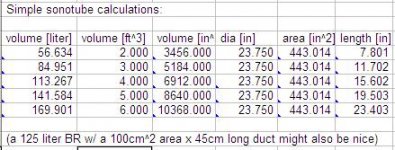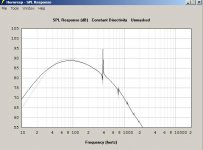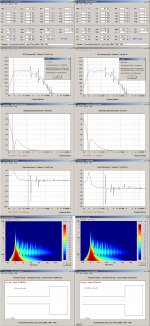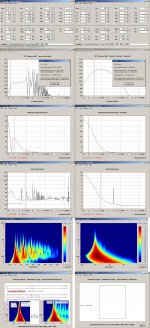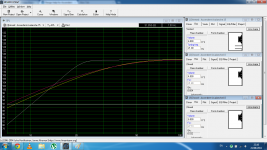I know there's some cabinet designing whizzes out there and I was hoping you guys could help me slam out a quick design for the Ascendent Audio Avalanche that I recently acquired.
I will be driving this sub with the following amp:
The Apex Junior Subwoofer Amp
I am wanting a sealed design, probably front firing (someone talked me out of down firing by saying it would wreck my floor), and mostly for HT use. I would like to have the option to use it in my 2 channel set up as well so I'm guessing this is another one of those "I want a musical sub" threads.
Both my HT room and my 2 channel room are not huge so glass shattering output is not a priority, overall sound quality is.
Thanks in advance for any help.
Here are the T/S specs:
Fs 15.7Hz
Qms 3.5
Qes .334
Qts .305
Vas 300.6L
Re 3.2ohms (coils in series)
Znom 4ohms (coils in series)
Xmax 27mm
Sd 748cm^2
Mms 269g
Vd 4.04L
RMS 800w
Le 2.4mH
Mounting info
Cutout Diameter 14.125”
Mounting Depth 7.875”
Diameter 15.5”
Read more: FS: 2 15" Ascendant Audio Avalache - Home Theater Forum and Systems - HomeTheaterShack.com
- Home Theater Forum and Systems - HomeTheaterShack.com
I will be driving this sub with the following amp:
The Apex Junior Subwoofer Amp
I am wanting a sealed design, probably front firing (someone talked me out of down firing by saying it would wreck my floor), and mostly for HT use. I would like to have the option to use it in my 2 channel set up as well so I'm guessing this is another one of those "I want a musical sub" threads.
Both my HT room and my 2 channel room are not huge so glass shattering output is not a priority, overall sound quality is.
Thanks in advance for any help.
Here are the T/S specs:
Fs 15.7Hz
Qms 3.5
Qes .334
Qts .305
Vas 300.6L
Re 3.2ohms (coils in series)
Znom 4ohms (coils in series)
Xmax 27mm
Sd 748cm^2
Mms 269g
Vd 4.04L
RMS 800w
Le 2.4mH
Mounting info
Cutout Diameter 14.125”
Mounting Depth 7.875”
Diameter 15.5”
Read more: FS: 2 15" Ascendant Audio Avalache
Alright, I guess I'll shoot for around 3 ft^3 (minus whatever I loose for the space the amp/driver/bracing use). That should keep my overall volume over 2 ft^3 but not too terribly large.
From my VERY limited understanding of the world of subwoofers, it sounds like exact volume is not SUPER important for a sealed design; correct?
From my VERY limited understanding of the world of subwoofers, it sounds like exact volume is not SUPER important for a sealed design; correct?
Alright, a little more follow up here. I did some more reading and finally decided I should at least try to use WinISD and here's what I've found. The manufacturer of this driver stated that it was designed to be used in a sealed design as small as 2.2 ft^3 and that is just about what WinISD told me as well. I read several other places that this sub is happy around 4 ft^3; just wondering if I'm doing any harm going bigger than the 2.2 ft^3.
Next question, read somewhere else that "for music a Q of about .7 is perfect." I really have no idea what that means and would appreciate some clarification on that point. I don't know what Q measures and the other didn't say why a Q of .7 was perfect for music.
Last question, the nuts and bolts of construction. I've read conflicting opinions on lining the intererior of the box; I think I'm planning on using the polyfill stuff but just want to confirm that I'm on the right track. Also, I'm assuming for a sealed sub that you really want it sealed. Does that mean I should use something like latex caulk to seal the interior seams? Also, do I want to use anything around the driver and the amp when I mount them?
Thanks in advance for all the help.
Next question, read somewhere else that "for music a Q of about .7 is perfect." I really have no idea what that means and would appreciate some clarification on that point. I don't know what Q measures and the other didn't say why a Q of .7 was perfect for music.
Last question, the nuts and bolts of construction. I've read conflicting opinions on lining the intererior of the box; I think I'm planning on using the polyfill stuff but just want to confirm that I'm on the right track. Also, I'm assuming for a sealed sub that you really want it sealed. Does that mean I should use something like latex caulk to seal the interior seams? Also, do I want to use anything around the driver and the amp when I mount them?
Thanks in advance for all the help.
Q
Hi,
All else being equal, the bigger a sealed box the lower the Qtc. Often manufacturers will reduce the box volume until they get a slight low frequency bump, or in other words a Qtc of .8 to .9.. Many listeners will prefer the gentler roll-off of a Qtc .5 box. Building a slightly larger box will allow you to tune the Q through the addition of damping material and wooden blocks, etc.....
Speaker Box Calculations
As to the nuts and bolts: polyfill (or fiberglass) is fine, caulking interior doesn't hurt (but the glue joint should be sufficient), and the speaker and amp should be sealed (including holes in connectors), e.g.: foam weather stripping (silicone caulk).
Regards,
Hi,
All else being equal, the bigger a sealed box the lower the Qtc. Often manufacturers will reduce the box volume until they get a slight low frequency bump, or in other words a Qtc of .8 to .9.. Many listeners will prefer the gentler roll-off of a Qtc .5 box. Building a slightly larger box will allow you to tune the Q through the addition of damping material and wooden blocks, etc.....
Speaker Box Calculations
As to the nuts and bolts: polyfill (or fiberglass) is fine, caulking interior doesn't hurt (but the glue joint should be sufficient), and the speaker and amp should be sealed (including holes in connectors), e.g.: foam weather stripping (silicone caulk).
Regards,
Last edited:
From my VERY limited understanding of the world of subwoofers, it sounds like exact volume is not SUPER important for a sealed design; correct?
No, it's not, but try to get as close as you can, it's never wrong to try to be accurate.
Next question, read somewhere else that "for music a Q of about .7 is perfect.". I don't know what Q measures and the other didn't say why a Q of .7 was perfect for music.
Last question, the nuts and bolts of construction. I think I'm planning on using the polyfill stuff but just want to confirm that I'm on the right track.
When calculating the box size in relation to Q, don't forget to account for room gain and the like. That means that if you are aiming for a final Q of say 0.7 you might want to make a box that is somewhere in the 0.6-0.65 range (I've been tol myself) to land around 0.7.
Normally, as far as I've understood, a sealed sub is to be filled 100%, and you can use ordinary glass fiber stuff. I've forgotten the exact products mentioned in Dickason's "Cookbook"
You might also want to consider the option of damping the interior walls of the box.
Well I hate to admit it, but life got in the way and both this driver and the amp are still in their boxes in my room waiting for me to get going on this project.
I've finally got my room set up and just want to make sure I'm still tracking with an appropriate design. This sub will be probably a 90% HT sub because my current sub keeps bottoming out in movies. It's a little Hsu sub that only has a 10" driver so there's only so much I can expect. It sounds great for music, but it's coming up short in movies.
Anyway, room size is only about 12x15, I don't need to fill a concert hall with sound, but I don't want my sub to bottom out every time Iron Man takes flight. Sealed still the way to go? The T/S specs are listed at the beginning of this thread. I'm still thinking about 4^3 ft for the box.
Thanks again for all the assistance. I hope to have something to show for it soon.
I've finally got my room set up and just want to make sure I'm still tracking with an appropriate design. This sub will be probably a 90% HT sub because my current sub keeps bottoming out in movies. It's a little Hsu sub that only has a 10" driver so there's only so much I can expect. It sounds great for music, but it's coming up short in movies.
Anyway, room size is only about 12x15, I don't need to fill a concert hall with sound, but I don't want my sub to bottom out every time Iron Man takes flight. Sealed still the way to go? The T/S specs are listed at the beginning of this thread. I'm still thinking about 4^3 ft for the box.
Thanks again for all the assistance. I hope to have something to show for it soon.
I would suggest getting an EP2000 amp to run the subwoofer, and why not go ported? 8 cubic feet, tuned to 20Hz, with an 8" port, gives you a huge increase in output in the 15-40Hz range, and if its for home theatre, that's perfect 
If you bridge the EP2000, it will deliver around 1100 watts, so a HPF at 16Hz would be a good idea.
If you bridge the EP2000, it will deliver around 1100 watts, so a HPF at 16Hz would be a good idea.
i think you'll be happy with a sealed 4ft^3 box. I'd use an amp with a parametric eq built-in but the one you have will get you on your way. remember, you can always build another box or add ports to the one you are going to build. a 4ft box will tune nice and low as long as you keep one dimension long enough for the ports. I always keep one side at 24" when I build a sealed box for a customer so i can add up to a 21"legnth x 3"dia. port if they want it to go lower.
important: don't go too far with finishes until you are happy, an unfinished box just means you're still in the testing phase
important: don't go too far with finishes until you are happy, an unfinished box just means you're still in the testing phase
i think you'll be happy with a sealed 4ft^3 box. I'd use an amp with a parametric eq built-in but the one you have will get you on your way. remember, you can always build another box or add ports to the one you are going to build. a 4ft box will tune nice and low as long as you keep one dimension long enough for the ports. I always keep one side at 24" when I build a sealed box for a customer so i can add up to a 21"legnth x 3"dia. port if they want it to go lower.
important: don't go too far with finishes until you are happy, an unfinished box just means you're still in the testing phase
Very good idea, I hadn't thought of that. I'll make sure one side is at least 24" and definitely leave it unfinished until I'm sure.
A 3" port would result in a extremely fast air velocity, and probably start to compress with more then 70 watts input power, you would need a 6" port minimum, and and 8" port preferable to avoid port compression and noise with a high excursion 15".
If you have the room, build a horn subwoofer, its nearly always going to give you the best output, I would build them, but I still have to get around to learning Horn response.
If you have the room, build a horn subwoofer, its nearly always going to give you the best output, I would build them, but I still have to get around to learning Horn response.
A 3" port would result in a extremely fast air velocity, and probably start to compress with more then 70 watts input power, you would need a 6" port minimum, and and 8" port preferable to avoid port compression and noise with a high excursion 15".
If you have the room, build a horn subwoofer, its nearly always going to give you the best output, I would build them, but I still have to get around to learning Horn response.
that would depend on how it's tuned, say you tuned the box to 8hz the max vent velocity at Xmax / 20Hz with two 3"ports would be around 10m/s, very usable. 3" was just an example.
With that driver and high tuning i'd use a slot port.
Going to 6^ft will lower the Qtc from .6 to around .5, not a problem if the sub is for HT.
6^ft tuned to 21Hz with a 6" port would be a nice sub indeed, problem is, with 800 watt (the drivers rating) the air port velocity is 32m/s which is too high.
What amp are you using?
6^ft tuned to 21Hz with a 6" port would be a nice sub indeed, problem is, with 800 watt (the drivers rating) the air port velocity is 32m/s which is too high.
What amp are you using?
Attachments
- Status
- This old topic is closed. If you want to reopen this topic, contact a moderator using the "Report Post" button.
- Home
- Loudspeakers
- Subwoofers
- Design help for Ascendent Avalanche 15
